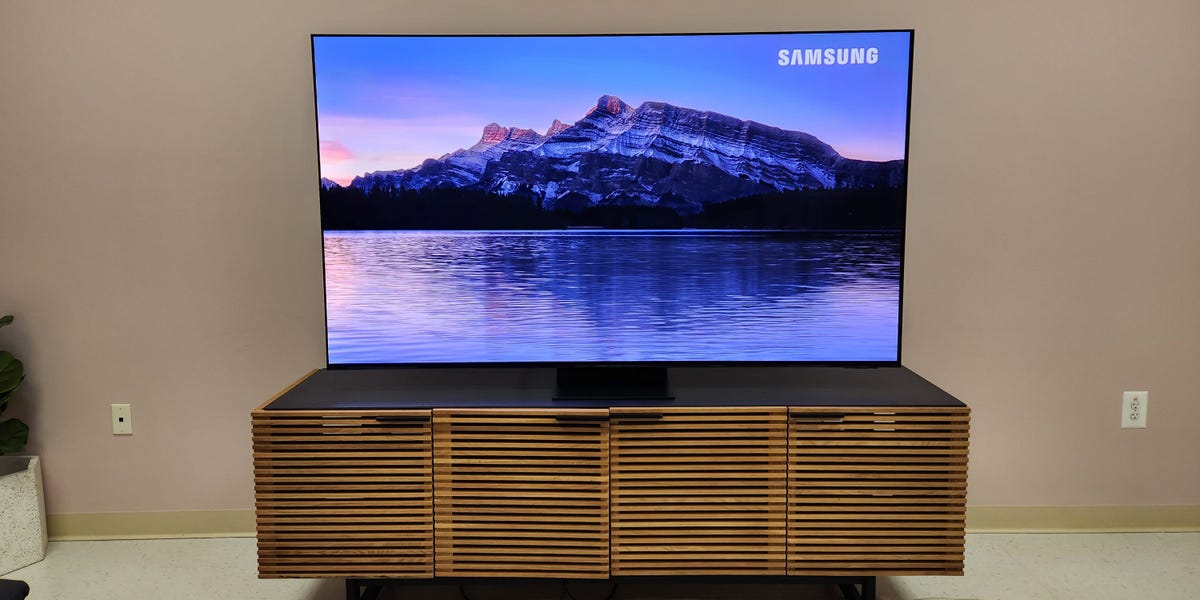When you buy through our links, Business Insider may earn an affiliate commission. Learn more
Samsung’s 2023 S95C OLED remains one of the best 4K TVs you can buy. With a QD-OLED panel that delivers an infinite contrast ratio, quantum dots that provide rich colors, a super-thin design, and a refresh rate of up to 144Hz, the TV checks nearly every box you should look for in a premium display, especially if you want a top OLED for gaming.
Compared to Samsung’s cheaper S90C, the S95C offers a few design perks and a 30% increase in brightness, which should appeal to big videophiles. However, there’s also a brand-new 2024 edition of this TV, called the S95D, to consider. The 2024 model is more expensive, but it’s even brighter and has a new anti-glare screen.
The S95C will get harder to find in stock as the year progresses and retailers start to phase out inventory in favor of the newer S95D. But while it remains available, the S95C is a solid in-between option for enthusiasts willing to pay for something a bit more advanced than the S90 series but who don’t want to shell out top dollar for the new flagship S95D.
Samsung 65-inch S95C 4K OLED TV
The S95C is one of Samsung’s top OLED TVs. It has a sleeker design and a brighter picture than step-down models, but it can’t quite reach the peak brightness of Samsung’s newer S95D.
One of the brightest OLED TVs you can buy
Steven Cohen/Insider
The S95C delivers high-end picture performance, with specs that hold their own against many top competitors, like the LG G series and the Sony A95L. The QD-OLED panel provides pixel-level contrast and the TV’s use of quantum dots helps it achieve top-of-the-line color range and volume.
Though overall image performance is very similar to the less expensive S90C, the S95C does offer an improvement in one notable area: brightness. The S90C can reach around 1,050 nits in its Filmmaker picture mode (the most accurate out-of-box setting), but the S95C peaks at around 1,360 nits. That’s about a 30% increase, which is impressive but not quite as high as the 1,700 nits that the more expensive 2024 S95D can hit. Colors also maintain brightness well, with high color volume that surpasses the performance of OLED panels that don’t use quantum dots (like LG’s).
This means the TV can do an excellent job of hitting the intended contrast levels of most high-dynamic-range (HDR) content, with highlights that really pop from the screen. It also delivers good performance in rooms that let in more outside light so you can still enjoy excellent image quality during the day. However, while the S95C’s screen does a decent job of reducing reflections, its glossy coating can’t combat glare as well as the matte coating used on Samsung’s new S95D. That said, the S95C does maintain black levels better with the lights on.
When watching movies and shows, the S95C’s impressive specs deliver gorgeous picture performance. The opening scene of “The Matrix” on 4K Blu-ray comes through with inky black levels and solid shadow detail. The police officers’ flashlights offer punchy specular highlights that really show off the benefits of the OLED panel’s precise contrast.
“Aquaman” is also a stunner on the S95C. The movie’s vibrant color palette looks rich without becoming oversaturated, and the film’s climactic underwater battle is bright and filled with intricate detail. The display’s quantum dots and increased color volume help it deliver an intensity in smaller highlights that dimmer OLED models simply can’t achieve.
Steven Cohen/Insider
Gradients are smooth, with only a faint hint of vertical banding in gray test patterns. The TV handles our banding test scene in “Ex Machina” well, too, with background colors that remain smooth in sequences that feature harsh red light. And like all OLED TVs, viewing angles are superb.
Regarding gaming, the S95C is a powerhouse with all the bells and whistles buyers should look for, including variable refresh rate (FreeSync and G-Sync compatible), auto low latency mode, and 4K/120Hz support for PS5 and Xbox Series X. The S95C also supports a higher 4K/144Hz refresh rate when connected to a compatible PC. Similar 2023 LG and Sony OLEDs don’t have this feature, so the S95C has a slight edge as a top gaming OLED.
On the downside, Samsung still doesn’t support Dolby Vision, which is an advanced HDR format that tells a TV how to render colors and brightness on a scene-by-scene basis. Dolby Vision content will instead play in standard HDR10, which isn’t quite as precise, but the S95C’s HDR10 performance is so strong that most people won’t notice a difference outside a side-by-side comparison with a high-end Dolby Vision TV.
HDR10+ is also supported, which delivers many of the same benefits as Dolby Vision, but that format isn’t used on nearly as many 4K Blu-ray discs or streaming titles. Check out our guide to HDR to learn more about the pros and cons of different high dynamic range formats.
Like all OLED TVs, there is technically some risk of burn-in on the S95C. Burn-in can occur if you leave a static image on the screen for hours on end, causing a faint shadow image to get stuck on the screen. Though OLED owners should be mindful of this, it will not affect users with regular viewing habits.
A uniformly thin design, but it uses an external box for inputs
Steven Cohen/Insider
As a premium TV, the S95C certainly looks the part. The display has an elegant build with a nearly bezel-less frame. And unlike the cheaper S90C, this model maintains a thin profile of 0.4 inches all the way around.
To achieve this sleek design, the TV houses all its ports and processing components in a separate “One Connect Box.” The box plugs into the display, and then you plug all your video devices into the box.
Steven Cohen/Insider
On the one hand, this design gives the S95C’s panel a strikingly narrow build, but it does mean that you have to deal with an extra component. Thankfully, the box can attach right to the back of the TV’s included pedestal stand, which makes it easy to hide out of view. It can also attach to the back of the TV if you wall mount it.
A solid smart TV experience
Steven Cohen/Insider
Samsung’s Tizen OS works well with easy access to all of the best streaming services, and the TV supports Bixby and Alexa built-in. Google Assistant is also supported but requires a separate device.
There’s also a dedicated Gaming Hub section, where you’ll find support for cloud services like Xbox Game Pass. This means Game Pass Ultimate subscribers can stream Xbox games directly on the TV without a console. As noted in my S95B 4K TV review, this feature is a cool perk you won’t currently find on smart TVs from other brands, but performance relies heavily on your internet connection. As it stands, playing on an actual console still delivers a much better experience.
Samsung’s compact remote gets the job done, and its SolarCell design means you never have to worry about batteries. Instead, the remote can continually recharge itself through the lights in your room. All you have to do is flip it over. USB-C charging is also supported.
On the downside, I still hate that Samsung cut a dedicated settings button from the remote. As it stands, you have to navigate through the info screen first to get to picture adjustments.
How does the 2023 S95C compare to the 2024 S95D?
Steven Cohen/Business Insider
When it was released in 2023, the S95C was Samsung’s flagship OLED TV. However, now that new 2024 models have hit stores, the S95C has been usurped by Samsung’s brand-new S95D, which is more expensive but offers a few performance upgrades. Like other 2023 TVs, the S95C will remain available to buy while supplies last, but stock will get harder to find as the year goes on.
The S95D and S95C have similar designs, but the S95D can get brighter and uses a new glare-free screen coating. During our tests, the S95D delivered a peak brightness of around 1,700 nits versus the S95C’s 1,360 nits. That’s an impressive increase and the highest measurement we’ve ever recorded on an OLED, but it should be noted that the S95D can only hit that number in short bursts. Likewise, only certain HDR videos will benefit from such high brightness capabilities, so the S95C’s performance remains sufficient for most movies and TV shows you’ll watch.
The S95D’s new glare-free coating might be an even more notable, albeit divisive, change from the S95C. This matte filter significantly reduces glare and reflections versus the S95C and any other OLED we’ve seen. This makes the S95D uniquely suited for bright rooms where glare is an issue. However, the matte screen does give black levels an elevated and flat look when displaying dim scenes with the lights on.
We’re a bit torn about the pros and cons of the filter, so the S95C remains a good alternative for buyers who favor preserving black-level performance over cutting down glare. But if you have problems with reflections in your room or you want the absolute brightest HDR performance you can get on an OLED, we think the S95D is worth the extra money.
With that in mind, the S95D has replaced the S95C as our top premium OLED recommendation in our guide to the best Samsung TVs. But the S95C remains a worthwhile purchase if you don’t like the S95D’s glare-free coating or you want to snag a high-end Samsung OLED for less money.
Should you buy the Samsung S95C?
Steven Cohen/Insider
The Samsung S95C is an excellent high-end display, and it’s still one of the best OLED TVs you can buy, especially if you want a premium gaming set. However, we think Samsung’s cheaper S90C 4K TV offers a better overall value for most viewers. And the more expensive 2024 S95D has some performance perks that might be worth the extra money for big home theater enthusiasts or people who need a TV that reduces glare.
On the other hand, some buyers may prefer the S95C’s glossy screen over the S95D’s matte coating, and the S95D’s higher peak brightness will only benefit some HDR titles. As it stands, the S95C provides a solid middle ground between Samsung’s most expensive and most affordable OLEDs with performance that should appeal to videophiles who want a high-end QD-OLED that costs under $3,000.




